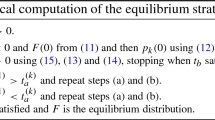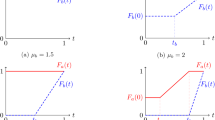Abstract
We consider series of M/M/m queues with strategic customer behavior. Customers arrive to the first queue and decide whether to enter the system or balk and, if they enter, up to which queue to proceed before departing. Each customer makes an independent decision, with the objective of maximizing her total net benefit, which is equal to the value of service minus a cost due to expected delay. We formulate the customer decision as a game and identify the unique symmetric Nash equilibrium strategy, which is expressed in a backward recursive form. We also analyze the problem of maximizing the total customer welfare and establish the relationship between the equilibrium and the welfare maximizing strategies.
Similar content being viewed by others
References
Afeche, P., & Mendelson, H. (2004). Pricing and priority auctions in queueing systems with a generalized delay cost structure. Management Science, 50(7), 869–882.
Altman, E., Boulogne, T., El-Azouzi, R., Jiménez, T., & Wynter, L. (2006). A survey on networking games in telecommunications. Computers & Operations Research, 33(2), 286–311.
Balachandran, K. R. (1972). Purchasing priorities in queues. Management Science, 18, 319–326.
Braess, D. (1968). Über ein paradoxon aus der verkehrsplanung. Unternehmensforschung, 12, 258–268.
Burnetas, A., & Economou, A. (2007). Equilibrium customer strategies in a single server Markovian queue with setup times. Queueing Systems, 56(3–4), 213–228.
Cohen, J. E., & Kelly, F. (1990). A paradox of congestion in a queueing network. Journal of Applied Probability, 27, 730–734.
Edelson, N. M., & Hildebrand, D. (1975). Congestion tolls for Poisson queueing processes. Econometrica, 43, 81–92.
Fudenberg, D., & Tirole, J. (1998). Game theory. Cambridge: MIT Press.
Ghoneim, H. A., & Stidham, S. (1985). Control of arrivals to two queues in series. European Journal of Operational Research, 21, 399–409.
Gibbons, R. (1992). Game theory for applied economists. Princeton: Princeton University Press.
Guo, P., & Hassin, R. Strategic behavior and social optimization in Markovian vacation queues. Operations Research (2011). doi:10.1287/opre.1100.0907.
Guo, P., & Zipkin, P. (2007). Analysis and comparison of queues with different levels of delay information. Management Science, 53(6), 962–970.
Hassin, R., & Haviv, M. (2002). Nash equilibrium and subgame perfection in observable queues. Annals of Operations Research, 113(1–4), 15–26.
Hassin, R., & Haviv, M. (2003). To queue or not to queue: equilibrium behavior in queueing systems. Berlin: Springer.
Katehakis, M., & Derman, C. (1989). On the maintenance of systems composed of highly reliable components. Management Science, 35, 551–560.
Katehakis, M., & Melolidakis, C. (1995). On the optimal maintenance of systems and control of arrivals in queues. Stochastic Analysis and Applications, 13, 137–164.
Kelly, F., Maulloo, A., & Tan, D. (1998). Rate control for communication networks: shadow prices, proportional fairness and stability. The Journal of the Operational Research Society, 49(3), 237–252.
Ku, C., & Jordan, S. (1997). Access control to two multiserver loss queues in series. IEEE Transactions on Automatic Control, 42, 1017–1023.
Lee, H. L., & Cohen, M. A. (1983). A note on the convexity of performance measures of M/M/c queueing systems. Journal of Applied Probability, 20, 920–923.
Masuda, Y., & Whang, S. (1999). Dynamic pricing for network service: equilibrium and stability. Management Science, 45, 857–869.
Mendelson, H., & Whang, S. (1990). Optimal incentive-compatible priority pricing for the M/M/1 queue. Operations Research, 38(5), 870–883.
Naor, P. (1979). The regulation of queue size by levying tolls. Econometrica, 37, 15–24.
Author information
Authors and Affiliations
Corresponding author
Rights and permissions
About this article
Cite this article
Burnetas, A.N. Customer equilibrium and optimal strategies in Markovian queues in series. Ann Oper Res 208, 515–529 (2013). https://doi.org/10.1007/s10479-011-1010-4
Published:
Issue Date:
DOI: https://doi.org/10.1007/s10479-011-1010-4




